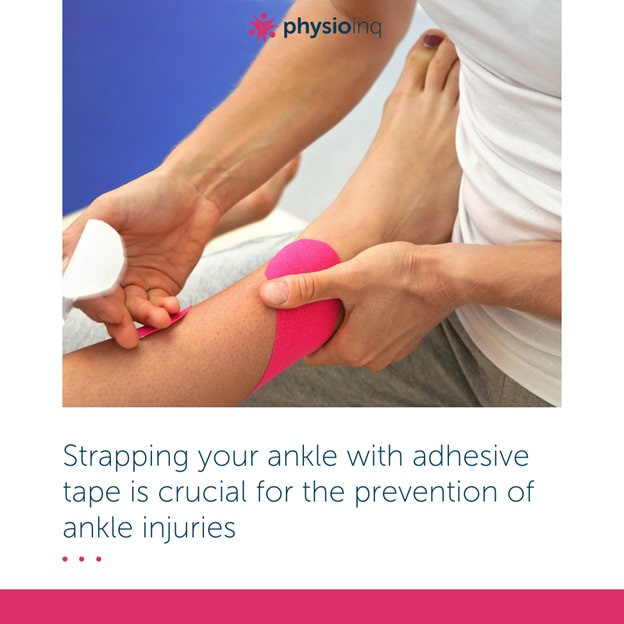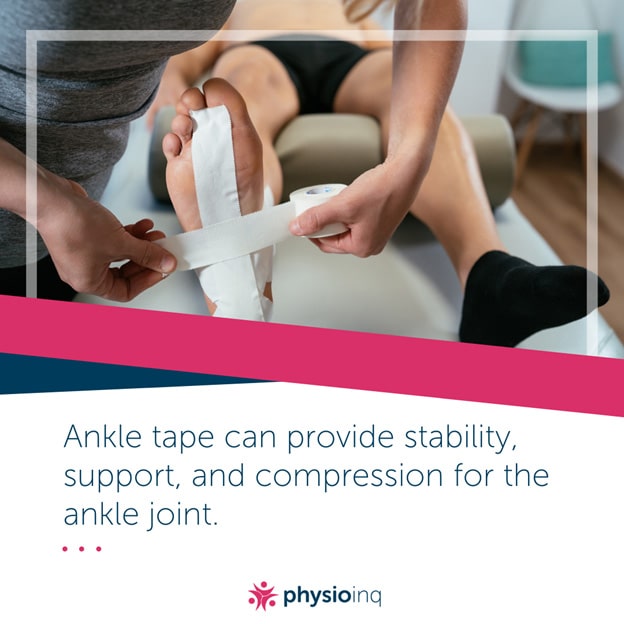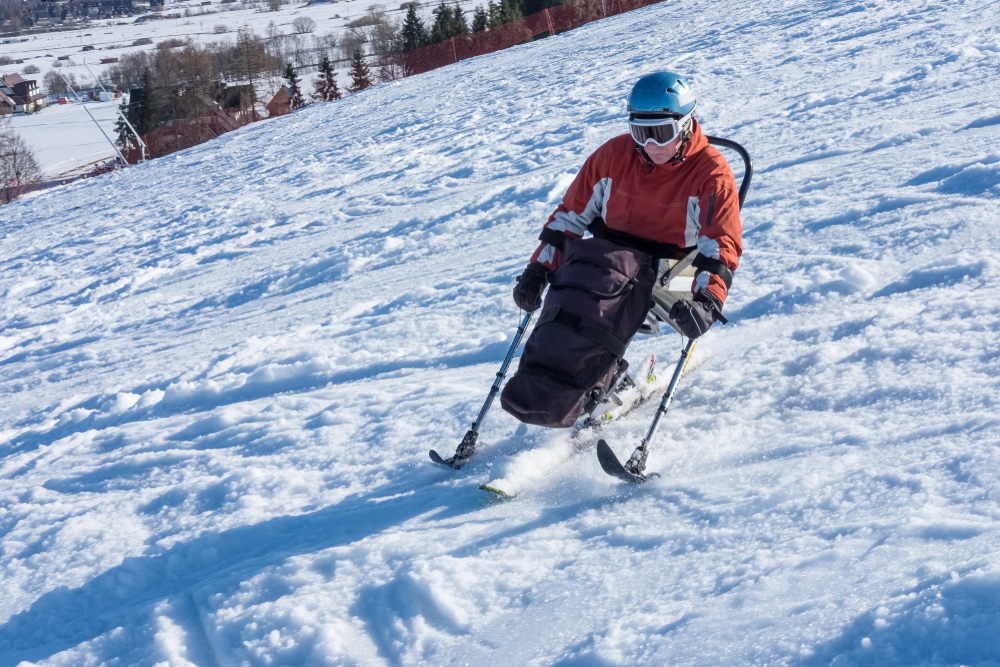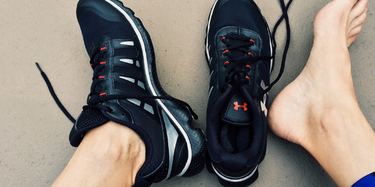Make an Appointment
You’ve probably seen athletes taping their ankles. Or you’ve had to wear ankle tape yourself after a sprain. But, how does one actually strap an ankle to relieve pain and prevent future injuries?
Here, we’re going over why people tape their ankles, how to strap an ankle and when to see a physiotherapist for any ankle issues. So, let’s get started.
Reasons You Might Need to Strap Your Ankle?
When you tape or strap your ankle correctly, these techniques can:
- Help ankle injuries move through the healing process
- Allow you to return to sport or other physical activities following an ankle injury
- Reduce the likelihood of aggravating your ankle injury
- Prevent future ankle injuries during high-risk sports or activities

However, there are some instances where strapping your ankle should be avoided, including:
- When you have certain injuries such as a fracture
- If you have a skin allergy that will react to the sports tape
- If the strapping technique increases your pain or causes discolouration, pins and needles, numbness, swelling or excessive redness in your foot or ankle
- If you have sensory or circulatory issues
In short, ankle tape should alleviate your painful symptoms from an ankle sprain or strain, not make them worse.
As your strength, range of motion and balance improve, you can wean off wearing the ankle tape. But, again, it’s recommended to be worn during high-risk activities or if you are prone to ankle injuries as a precaution.
What kind of tape should I use to strap my ankle?
There are various tapes and bandages you can use as ankle strapping tape. Generally, any kind of adhesive, rigid sports tape is appropriate. The two main options for ankle tape that you can use are known as athletic tape and Kinesio tape.
Athletic Tape
Athletic tape is specifically designed to restrict movement and protect your joints from injury. The tape doesn’t stretch and therefore stabilises an injured ankle and prevents future injury by limiting most of the movement of your ankle.
In general, the athletic tape should only be worn for a limited time, sometimes only less than a day, as this rigidity can affect your circulation, unless your doctor or physiotherapist suggests otherwise.
Kinesio Tape
Kinesio tape, on the other hand, is stretchy and moveable. This type of tape is best for when you require more range of motion in your ankle but need some extra support. Kinesio tape might be best for you if:
- You’re returning to sport or physical activity after an ankle injury
- You have unstable ankles in general
Kinesio tape can be worn for longer periods than athletic tape, even up to five days. With its stretchy, flexible nature, the tape shouldn’t restrict your circulation and is often waterproof. It can be worn in the shower and in your sleep, but for no longer than five days at a time.
In addition to ankle tape, some might also use special accessories to increase the tape’s effectiveness while reducing the prevalence of blisters or discomfort including:
- Heel and lace pads that are applied on the top of the foot or over the heel
- Taping base spray to reduce friction and better adhesion
- Pre wrap, which a soft, stretchy wrap applied underneath the ankle tape, making it easier to remove
How do you strap an ankle step by step?
Applying Rigid Athletic Tape
Step 1 - Apply pre-wrap to your foot by starting under the ball of your foot and wrapping in an upward motion toward the ankle to the point where up to three inches above the ankle is covered. If you prefer not to use pre-wrap, make sure your skin is completely clean and dry. You may also want to shave any hair from your ankle one to two days before to make the removal process less painful.
Step 2 - Using athletic tape, apply two anchor strips at the upper-most part of the pre-wrap. Start at the front of the leg and wrap around until the strips overlap by one or two inches. Then, apply an extra strip halfway beyond the first strip’s location.
Step 3 - Create a stirrup by applying another piece of tape against the top of one anchor strip, moving it over the ankle, over the heel and ending in the same spot on the opposite side. It should look like a stirrup.
Step 4 - Repeat and add another stirrup piece closer to the centre of the top of your foot, going around your ankle and sticking the tape to the anchor strip.
Step 5 - Attach another anchor strip over the stirrup tape, wrapping halfway from the start of the previous anchor tape. This step helps hold the stirrup piece firmly in place. Continue this wrapping pattern until you reach the top of your foot.
Step 6 - Wrap your heel using a figure-eight pattern by starting at the inner arch, pulling the tape on an angle across your foot toward your heel. Cross over your ankle in a figure-eight for two complete wraps.
Step 7 - Finish it off by taping from the front of your lower leg, around your arch or heel to the other side. Your skin should be completely covered with tape.
Applying Kinesio Ankle Tape
Step 1 - Start with a piece of Kinesio tape on the outside of the ankle about four to six inches above the ankle. Create a stirrup by taking the tape over the heel, pulling it to the opposite side and taking it over the inner ankle and stopping at the same place you started.
Step 2 - Place another piece of tape on the back of the foot in line with your Achilles tendon. Wrap the tape around the ankle, circling it around the foot, tight enough to be supportive, but not too tight that you can’t bend your ankle.
Step 3 - Instead of circling the foot, you can also cross the tape into an “X” shape by centring the tape under the arch and bringing each end across the front of your lower leg making an “X”, securing each piece behind the leg. Different from athletic tape, Kinesio tape won’t cover the entire area and you may have some skin exposed after this final step.
Keep in mind that the safest way to apply ankle tape is by working with a physiotherapist or other health professional. Various taping methods exist and it’s important, especially if it’s you’re first time strapping your ankle with tape to learn from a physio based on your specific ankle needs.
How do you wrap an ankle for support?
There are a few different ways to wrap an ankle for support. Here are some key terms that can help you follow step-by-step directions for applying ankle strapping tape.
- Anchor: Provides a firm base
- Stirrup: Vertical “U” shape to support both sides of your ankle
- Spur: Horizontal “U” shape to hold your ankle in place
- Basket-Weave: Stirrup and spur are both used and overlap for additional support
- Locking Straps: Short circles of tape to lock in the ankle tape
- Foam Padding: Where foam is used to fill in any empty space for extra support
- Figure-Six: Starts as a stirrup and then crosses to form a figure six to support and reinforce one side of your ankle
- Interlocking Sixes: Figure-six taping techniques that overlap to provide extra support to one side of your ankle
- Half-Heel Lock: Making a ‘U” shape to lock in one side of your heel which can be done on either side
- Full Heel Lock: Two half-heel locks at the same time
- Figure-Eight: Wrapping the ankle around the heel in a figure-eight pattern
- Spiral Taping: Spiraling the tape around the entire area of the ankle
Again, it’s important to consult with a physiotherapist if you’re unsure how to strap an ankle or if you’re experiencing any pain or discomfort after taping your ankle.
Should I wrap my ankle if it hurts?
It depends. It’s more important to figure out why your ankle is hurting before deciding to wrap it.
If you sprained your ankle or it’s otherwise inflamed, wrapping your ankle should offer you support and pain relief. However, if your ankle is fractured or badly injured, wrapping your ankle might not be the best solution.
Always speak to your doctor or book an appointment to see a physiotherapist if you’re experiencing any chronic ankle pain. Once your physio teaches you how to strap an ankle, you can then use those techniques to prevent ankle injuries or deal with any future ankle pain.
Does taping your ankle help?
Yes, taping your ankle helps with ankle sprains and helps to prevent ankle injuries, especially if you play high-risk sports, have weak ankles or perform activities such as hiking on uneven surfaces where your ankles may need extra support.

Keep in mind that wrapping an ankle too tightly can restrict circulation to your ankle injury, interfering with the healing process and potentially causing tissue damage.
But, wrapping the ankle too loosely means that your ankle isn’t getting the recovery support it needs from the ankle tape.
So, to get the most benefits out of taping your ankle, remember to:
- Learn how to strap an ankle from your physiotherapist
- Get the proper materials (athletic tape or Kinesio tape)
- Wash and dry the ankle area before taping or use pre-wrap
- Take your time when wrapping your ankle
Should you sleep with your ankle wrapped?
It depends. You should not sleep with your ankle wrapped in athletic tape but you can sleep with your ankle wrapped in Kinesio tape.
Athletic tape is rigid and won’t allow for much movement. Athletic tape should only be worn for a few hours at a time.
Kinesio tape is flexible and waterproof. You can wear Kinesio tape for up to five days at a time including while showering and sleeping.
--
As always, be sure to see your doctor or talk to your physiotherapist to make sure wrapping your ankle is the best way to treat your condition. Also, please note that the tips and recommendations listed above should not substitute medical advice.
Furthermore, never disregard advice given by your doctor or physiotherapist because of anything mentioned here.
To book an appointment with one of our friendly physiotherapists at Physio Inq, you can do so online. Come see us in one of our convenient Australian clinics or let our mobile physio services come to you.
If you need to make a referral, fill out our Allied Health Form.
Date Published: Tuesday, June 15, 2021
Locate a Mobile Physiotherapy
Service Near me
Get the experience & convinence you deserve to support your or a loved one's allied health needs.
Our Mobile Physiotherapy team are currently serving & taking appointments in the following states and regions in Australia:
Need to get into direct contact with ur Client Services team? We're all ears. Call our team directly on 1300 731 733













